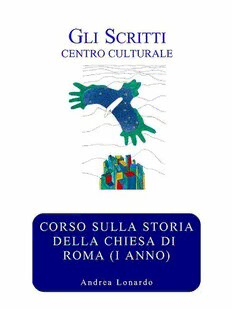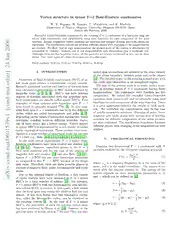
A Massive Data Parallel Computational Framework for Petascale/Exascale Hybrid Computer Systems PDF
Preview A Massive Data Parallel Computational Framework for Petascale/Exascale Hybrid Computer Systems
A Massive Data Parallel Computational Framework for Petascale/Exascale Hybrid 2 1 Computer Systems 0 2 n a MarekBLAZEWICZaStevenR.BRANDTb,cPeterDIENERb,d J DavidM.KOPPELMANeKrzysztofKUROWSKIaFrankLÖFFLERb 0 1 ErikSCHNETTERf,b,g JianTAOb aApplicationsDepartment,Poznan´ SupercomputingandNetworkingCenter,Poland ] C bCenterforComputation&Technology,LouisianaStateUniversity,BatonRouge,USA D cDepartmentofComputerScience,LouisianaStateUniversity,BatonRouge,USA . dDepartmentofPhysics&Astronomy,LouisianaStateUniversity,BatonRouge,USA s c eDepartmentofElectricalandComputerEngineering,LouisianaStateUniversity, [ BatonRouge,USA 1 fPerimeterInstituteforTheoreticalPhysics,Waterloo,Canada v gDepartmentofPhysics,UniversityofGuelph,Guelph,Canada 8 1 1 Keywords.hybridsystem,stencilcomputations,CFD,computationalframework, 2 largescalescientificapplication . 1 0 2 1 : Introduction v i X HeterogeneoussystemsarebecomingmorecommononHighPerformanceComputing r a (HPC)systems.EvenusingtoolslikeCUDA[1]andOpenCL[2]itisanon-trivialtask toobtainoptimalperformanceontheGPU.Approachestosimplifyingthistaskinclude Merge[3](alibrarybasedframeworkforheterogeneousmulti-coresystems),Zippy[4] (aframeworkforparallelexecutionofcodesonmultipleGPU’s),BSGP[5](anewpro- gramminglanguageforgeneralpurposecomputationontheGPU)andCUDA-lite[6](an enhancementtoCUDAthattransformscodebasedonannotations).Inaddition,efforts are underway to improve compiler tools for automatic parallelization and optimization ofaffineloopnestsforGPU’s[7]andforautomatictranslationofOpenMPparallelized codestoCUDA[8]. Inthispaperwepresentanalternativeapproach:anewcomputationalframeworkfor thedevelopmentofmassivelydataparallelscientificcodesapplicationssuitableforuse onsuchpetascale/exascalehybridsystemsbuiltuponthehighlyscalableCactusframe- work[9,10]Asthefirstnon-trivialdemonstrationofitsusefulness,wesuccessfullyde- velopedanew3DCFDcodethatachievesimprovedperformance. 1. CactusComputationalFramework TheCactusframework[9,10]wasdesignedanddevelopedtoenhanceprogrammingpro- ductivityinlarge-scalesciencecollaborations.ThedesignofCactusallowsscientistsand engineerstodevelopindependentcomponentsforCactuswithoutworryingaboutporta- bilityissuesoncomputingsystems.ThecommoninfrastructureprovidedbyCactusalso enablesdevelopingscientificcodesthatworkacrossdifferentdisciplines.Thisapproach emphasizes code re-usability, and greatly simplifies constructing sound interfaces and well-testedandwell-supportedsoftware.AsthenameCactussuggests,theCactusframe- workconsistsofacentralcorecalledflesh,whichprovidesinfrastructureandinterfaces formodularcomponentscalledthorns. Buildingupontheflesh,thornscanprovideimplementationsforcomputationalcon- ceptssuchasparallelization,meshrefinement,I/O,check-pointing,webservers,andso forth. The Cactus Computational Toolkit (CCTK) is a collection of thorns which pro- videbasiccomputationalcapabilities.ApplicationthornsmakeuseoftheCCTKviathe Cactus flesh API. Cactus is well suited for domain discretizations via regular, block- structuredgridsasarecommone.g.forhigherorderfinitedifferences.TheCarpetAMR library[11,12]implementstherecursiveblock-structuredAMRalgorithmbyBergerand Oliger [13], and provides support for multi-block (or multi-patch) domain discretiza- tions.AsetofexplicittimeintegrationschemessuchasRunge-Kuttamethodsarepro- vided by a Method of Lines time integrator. Overall, the Cactus framework hides the detailedimplementationsofCarpetandotherutilitythornsfromapplicationdevelopers. 1.1. MPI-BasedDataParallelisminCactus The Cactus framework adopts the idea of data parallelism in its design and implemen- tation. In Cactus, the computational grid is decomposed into multiple components that are distributed between processes, and the same set of operations are applied to each. ThecommunicationcomponentofCactususestheMessagePassingInterface(MPI)to exchangedatabetweenprocesses.InCactus,itisthetaskofaspecialdrivercomponent to set up storage for variables, partition the grid between MPI processes, and manage inter-processcommunication.Unlikephysicalboundarieswheretheboundarydatacan besetorcalculatedfromboundaryconditions,dataatinter-processboundariesneedto becopiedfromotherprocesseswheretheneighboringgridcomponentsarelocated.This is implemented via a ghost region at the inter-process boundaries that is automatically setupbythedriver.Thenecessarysizeofaghostregiondependsonthenumericalalgo- rithmsusedandcanbeselectedasparametersatrun-time. 1.2. ParallelizationonCPU-GPUHybridSystems The data parallelism in Cactus matches well with the features of CUDA [14] and OpenCL[15]insupportingprogrammingonhybridcomputersystems.Onthecomputa- tionalframeworklevel,thereisnotmuchdifferencebetweenCUDAandOpenCLwhen targeting NVIDIA Fermi-class GPU’s. In this work we only focus on the paralleliza- tion on the CUDA architecture, and will present a computational framework based on OpenCLinalaterpublication. BasedupontheCUDAarchitecture,webuildanMPI-CUDAbasedcomputational frameworkinCactus1.Itenablesasimple,semi-automatic,yetefficientimplementation andexecutionofCUDA-enabledapplications.Auto-tuningenablesefficientdatadistri- bution between nodes, effectively hiding additional cost introduced by GPU-host and host-host interconnections.The computational overhead in such a generic framework is greatly reduced by overlapping data transfers and computation with the asynchronous data transfers and concurrent copy and execution supported in CUDA. With the help fromsuchacomputationalframework,applicationdeveloperscanthenspendmoretime optimizingthenumericalkernelitself,implementingmoreefficientalgorithmsinthese kernels,and(mostimportantly)advancingthesciencecontentintheircode. This system has been tested and benchmarked on a 3D CFD implementation (see section4)basedonafinitedifferencediscretizationofNavier-Stokesequations. Boundary Boundary Conditions Conditions Node 1 Node 2 Node N MPI_Send MPI_Send MPI_Send MPI_Recv MPI_Recv MPI_Recv CPU CPU CPU cudaMemCpy cudaMemCpy cudaMemCpy (cid:7)GPU (cid:7)GPU (cid:7)GPU Figure 1. The Cactus computational framework manages the domain decomposition and communication amongthesplitdomainsviaMPI.ComputationsareperformedprimarilyonGPU’s.Thedatatransfersbetween CPU’saswellastoandfromtheGPU’sareconcurrentwiththecomputation. 2. GPGPUProgramminginCactus AchievingefficientexecutiononaGPUoftenrequirescarefulanalysisoftheapplication followed by extensive testing and tuning. For many important problems, such as linear algebraroutines,thisworkhasbeendoneandpackagedintolibrariesforconvenientuse byothers[16]. Iterativegridtechniquesarewidelyused,andseemlikeagoodfitforthehighfloat- ingpointdensityofGPU’s.Butbecauseeachinvestigatormayrunadifferentgridkernel asimplelibraryroutinewouldnotachievewideuse.GPUimplementationsofiterative gridalgorithmsmustdealwiththeproblemofghostzoneexchangemademoretedious by GPU memory access constraints, among other factors. On conventional cluster sys- tems iterative grid application programmers do not need to consider such issues when usingaframeworklikeCactus.Cactusmanagesdatacommunicationbetweenacluster’s nodes,includingghostzoneexchange,sothatapplicationcodeneedonlyoperateonthat data.TheproblemsrelatedtoghostzoneinterchangebetweenCUDAblocksissimilarin manywaystoghostzoneinterchangebetweenprocessorsinaclusterCPUconfiguration. Inthiswork theCactusframeworkhas beenextendedtocover GPUexecutionvia anarchitectureneutralprogrammingabstractiontohighlyoptimizefinitedifferenceop- erationsinamultithreadedcomputingenvironment(seelist1). Figure2. TheworkflowchartofaCaCUDA-basedapplication.Theupperboxshowsthegenerationofthe CaCUDAkernelheadersatthecodecompilationstage.Thelowerboxshowshowthevariablesareevolvedto thenexttimestep. 3. CaCUDAKernelAbstraction ThetaskofsimplifyingthegenerationofCUDAcodeforafinitedifferencingcodeisnot a straightforward one. Shared arrays with appropriate stencil sizes have to be carefully managed,anddataneededbythestencilhastobestreamedinwhilecalculationsproceed. Itispossibletoabstractawaymuchofthedifficultworkintoboilerplatecode,butdoing sorequiressomeextramachinery.Wedesignandimplementaprogrammingabstraction intheCactusframeworktoenableautomaticgenerationfromasetofhighlyoptimized templatestosimplifycodeconstruction.TheworkflowchartofatypicalCaCUDA-based applicationcanbefoundinfigure2. TherearethreemajorcomponentsinourCaCUDAKernelabstraction. 1. CaCUDAKernelDescriptor isusedtodeclarethevariablesthatwillbeneeded intheGPGPUcomputation,andidentifyafewrelevantproperties. 2. CaCUDATemplatesareasetoftemplateswhicharehighlyoptimizedforpartic- ulartypesofcomputationaltasksandoptimizationstrategies. 3. CaCUDACodeGeneratorisusedtoparsethedescriptorsandautomaticallygen- erate CUDA-based macros. The code generator is based on Piraha[17], which implementsatypeofparsingexpressiongrammar[18].Duetothepagelimit,we donotlistthetemplatesandthesamplecodegeneratedbyCaCUDA.Moreabout theCaCUDAprojectcanbefoundattheCaCUDAprojectsite[19]. Listing1:AsamplekerneldefinitioninCactus CCTK_CUDA_KERNEL UPDATE_VELOCITY TYPE=3DBLOCK STENCIL="1,1,1,1,1,1" TILE="16,16,16" { CCTK_CUDA_KERNEL_VARIABLE CACHED=YES INTENT=SEPARATEINOUT { vx, vy, vz } "VELOCITY" CCTK_CUDA_KERNEL_VARIABLE CACHED=YES INTENT=IN { p } "PRESSURE" CCTK_CUDA_KERNEL_PARAMETER { density } "DENSITY" } The above kernel abstraction can be integrated in a straightforward manner as a thorn (module),CaCUDAinCactuswithouttouchingtheflesh(coreinfrastructure).Thekernel descriptorinthisabstractionissimilarinbothformatandfunctionalitytothoseCactus Configuration Language (CCL) files, which are used to declare global data structures, runtime parameters, and the way various C or Fortran subroutines interact through the scheduletree.TheabstractionsalreadyusedbyCactusare:param.ccl,configuration.ccl, schedule.ccl, and interface.ccl. To this set we add an additional declarative file called cacuda.ccl.TheCactusFrameworkalreadyhasamechanism,implementedthroughthe configuration.ccl file, by which discovery of additional preprocessing code can be en- abledpriortothecompilationofC/Fortrancode. 4. CFDImplementation ComputationalFluidDynamics(CFD)isoneofthebranchesoffluidmechanicswhich uses numerical methods and algorithms to solve and analyze fluid flows. It is success- fullyusedinvariousfieldsofscienceandengineeringsuchasweatherforecasting,aero- dynamicoptimizationofbodyshapes(e.g.planes,cars,ships),gasreservoiruncertainty analysis.UnfortunatelyaccurateCFDsimulationsneedgreatcomputationalpower.Itis veryimportanttoadaptexistingalgorithmstonewhybridarchitecturesandexecutethem inamassivelyparallelmanner. 4.1. BackgroundandGoverningEquations The CFD numerical method is governed by Navier-Stokes incompressible equations whicharederivedfromNewton’ssecondlaw(conservationofmomentum)andconser- vationofmass(incompressibility).TheNavier-Stokesequationsare Figure3. Thefiguretotheleftshowsthequantitativecomparisonofmidsectioncenterlinevelocitywiththose byGhiaetc.[22].TheonetotherightshowsthecontoursoftheXcomponentofthevelocityfieldalongY axis. ∂u +(u·∇)u=−∇φ+ν∇2u+f (1) ∂t ∇·u=0 (2) where u is the velocity field, ν is the the kinematic viscosity, f is the body force, φ is themodifiedpressure(pressureoverdensity).Thepresentedequationsneedtobefurther discretizedinordertoperformpropersimulation.Inthisprocesswehavefollowed[20] and[21].Theequationsarediscretizedusingafinite-differencemethod.Thecomputa- tionaldomainisdistributedontoaregularrectangularandstaggeredgrid.Thecomputa- tionsareperformedinthestencilpattern.Thisimpliesthatcalculationsareperformedin closeneighborhoodofeachgrid’scell. 4.2. CodeValidationandVerification A homogeneous distribution of computations for the lid-driven cavity problem with a Reynoldsnumberof100wasusedtobenchmarktheoverallperformanceoftheframe- workandverifythenumericalimplementation.Weshowthequantitativecomparisonof midsectioncenterlinevelocitywiththosebyGhiaetc.[22]infigure3. While these results come from a terascale machine, there is no logical barrier to continuedscaling,andweplantocontinuescalingstudiesasresourcesbecomeavailable. 4.3. PerformanceandScalability Wecarriedoutperformanceandscalingtestsona6nodeGPUclusteratCyfronet.Each nodehad2TeslaM2050GPU’s,twoIntelXeonX5670processorsrunningat2.93GHz, and an infiniband interconnect. The CFD code was measured for both the standalone code and the CaCUDA framework-based code. The performance results of one node were43.5and58GFlop/sforthestandalonesimulationandthesimulationimplemented withinCaCUDArespectively.Thescalabilityresultsofthe3DCFDcodethatmakesuse oftheCaCUDAframeworkaswellasthestandaloneversionareshowninfigure4. Linear standalone simulation scaling Standalone simulation speedup CaCUDA simulaiton speedup 12 10 8 p u ed- 6 e p S 4 2 0 0 1 2 3 4 5 6 7 8 9 10 11 12 Number of GPU’s Figure4. Thisplotcomparesthespeed-upoftheCFDcodebuiltwithCaCUDAtothestandalone,handwritten implementation.Speed-upsarecomputedrelativetotheperformanceofthestandalonecodeonasinglenode usingasingleGPU. 5. Conclusions In this paper an implementation of a new generic capability for computing on hybrid CPU/GPUarchitecturesintheCactuscomputationalframeworkhasbeenpresented.The capability to handle the data exchange between GPU and CPU address space and de- ploying the computations in the hybrid environment was implemented as a new thorn “CaCUDA”.Moreovertheapplicationremarkablyfacilitatestheimplementationprocess by generating the templates of all declared kernel functions. Due to the flexibility and extensibility of the Cactus framework no changes to the Cactus flesh were necessary, guaranteeingthatexistingfeaturesanduserimplementedthornsarenotaffectedbythis addition. Asatestcaseapplicationofthesenewframework’sfeaturesanincompressibleCFD code has been implemented to test the overall performance and scalability. The results provingitsusabilityhavebeenpresented. Ourcurrenteffortisfocusedonminimizingthecostsofthedataexchangebetween GPU and CPU and optimizing the boundary exchange. Further integration in this area mayimproveperformanceandscalability. Acknowledgments ThisworkissupportedbytheCybertools(http://cybertools.loni.org)project(NSFaward 701491), the NG-CHC project (NSF award 1010640) through the Louisiana Board of Regents , and the NSF award PIF-0904015 (CIGR). This work used the computer re- sources provided by LSU/LONI. This research was supported in part by PL-Grid In- frastructure. This work is also supported by the UCoMS project under award number MNiSW(PolishMinistryofScienceandHigherEducation)Nr4691N-USA/2009in close collaboration with U.S. research institutions involved in the U.S. Department of Energy(DOE)fundedgrantunderawardnumberDE-FG02-04ER46136andtheBoard ofRegents,StateofLouisiana,undercontractno.DOE/LEQSF(2004-07).Theauthors want to thank our colleagues at both CCT and PSNC for great ideas and discussions. TheauthorswanttothankSoon-HeumKofromtheNationalSupercomputingCentreat LinköpinginSwedenforhelpingvalidatingtheCFDcode. References [1] NVIDIACorporation2011NVIDIACUDACProgrammingGuideNVIDIACorporation [2] MunshiA(ed)2011TheOpenCLSpecificationVersion:1.1(TheKhronosGroup)URLhttp://www. khronos.org/registry/cl/specs/opencl-1.1.pdf [3] LindermanMD,CollinsJD,WangHandMengTH2008SIGPLANNot.43(3)287–296ISSN0362- 1340 [4] FanZ,QiuFandKaufmanAE2008ComputerGraphicsForum27341–350ISSN1467-8659 [5] HouQ,ZhouKandGuoB2008ACMTrans.Graph.27(3)19:1–19:12ISSN0730-0301 [6] UengSZ,LatharaM,BaghsorkhiSandHwuWm2008LanguagesandCompilersforParallelCom- puting(LectureNotesinComputerSciencevol5335)edAmaralJ(SpringerBerlin/Heidelberg)pp 1–1510.1007/978-3-540-89740-8_1URLhttp://dx.doi.org/10.1007/978-3-540-89740-8_1 [7] BaskaranMM,BondhugulaU,KrishnamoorthyS,RamanujamJ,RountevAandSadayappanP2008 Proceedingsofthe22ndannualinternationalconferenceonSupercomputingICS’08(NewYork,NY, USA:ACM)pp225–234ISBN978-1-60558-158-3URLhttp://doi.acm.org/10.1145/1375527.1375562 [8] LeeS,MinSJandEigenmannR2009SIGPLANNot.44(4)101–110ISSN0362-1340 [9] GoodaleT,AllenG,LanfermannG,MassóJ,RadkeT,SeidelEandShalfJ2003HighPerformance ComputingforComputationalScience-VECPAR2002,5thInternationalConference,Porto,Portugal, June26-28,2002(Berlin:Springer)pp197–227 [10] CactusFrameworkURLhttp://www.cactuscode.org [11] SchnetterE,HawleySHandHawkeI2004Class.QuantumGrav.211465–1488gr-qc/0310042 [12] AdaptiveMeshRefinementwithCarpetURLhttp://www.carpetcode.org/ [13] BergerMJandOligerJ1984J.Comput.Phys.53484–512 [14] NVIDIA CUDA (Compute Unified Device Architecture) URL http://www.nvidia.com/object/cuda_ home_new.html [15] OpenCL(OpenComputingLanguage)URLhttp://www.khronos.org/opencl/ [16] VolkovVandDemmelJW2008Proceedingsofthe2008ACM/IEEEconferenceonSupercomputing SC’08(Piscataway,NJ,USA:IEEEPress)pp31:1–31:11ISBN978-1-4244-2835-9URLhttp://portal. acm.org/citation.cfm?id=1413370.1413402 [17] SRBrandtGA2011201011thACM/IEEEInternationalConferenceonGridComputing [18] FordB2004Proceedingsofthe31stACMSIGPLAN-SIGACTSymposiumonPrinciplesofProgram- mingLanguages [19] CaCUDAMPI+CUDAProgrammingFrameworkURLhttp://code.google.com/p/cacuda/ [20] HirtCandNicholsB1981JournalofComputationalPhysics [21] TorreyMD,CloutmanLD,MjolsnessRCandCWHir1985NASA-VOF2D:AComputerProgram IncompressibleFlowswithFreeSurfacesTech.rep.LosAlamosNationalLaboratory [22] GhiaU,GhiaKNandShinCT1982JournalofComputationalPhysics48387–411ISSN0021-9991
The list of books you might like

Can’t Hurt Me: Master Your Mind and Defy the Odds

The 48 Laws of Power

Haunting Adeline

Atomic Habits James Clear

Sledgehammers: Strengths and Flaws of Tiger Tank Battalions in World War II

ANSI NEMA CC-1-2009 Electric Power For Substations

A Summary of Lightpipe Radiation Thermometry Research at NIST

NASA Technical Reports Server (NTRS) 20080015510: Utilizing Calibrated GPS Reflected Signals to Estimate Soil Reflectivity and Dielectric Constant: Results from SMEX02

NASA Technical Reports Server (NTRS) 20080014294: Arbitrary Steady-State Solutions with the K-epsilon Model

Excess conductance of a spin-filtering quantum dot

Diagnosing Energy Loss: PHENIX Results on High-pT Hadron Spectra

Corrections to scaling in multicomponent polymer solutions

TS 125 323 - V6.4.0 - Universal Mobile Telecommunications System (UMTS); Packet Data Convergence Protocol (PDCP) specification (3GPP TS 25.323 version 6.4.0 Release 6)

Random-energy model in random fields

c

Large mass enhancement in RbOs2O6

Corso sulla storia della chiesa di roma

Vortex structure in spinor F=2 Bose-Einstein condensates

Mitigation of Natural Hazards and Disasters: International Perspectives

of Mexico by C Reginald Enock

Radio Shack CoCo Manual: Schematic Diagram Kit (1993)(Disto Super Products)



